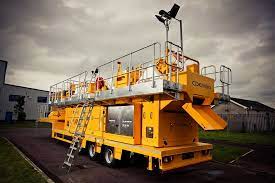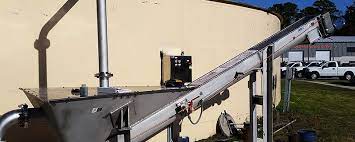Collected grit must be removed from the chamber, dewatered, washed, and conveyed to a disposal site. Some smaller plants use manual methods to remove grit, but grit removal is usually accomplished by an automatic method.
The four methods of automatic grit removal include inclined screw or tubular conveyors, chain and bucket elevators, clamshell buckets, and pumping.
A two-step grit removal method is sometimes used, where grit is conveyed horizontally in a trough or channel to a hopper, where it is then elevated from the hopper to another location.
Aerated grit chambers use a sloped tank bottom in which the air roll pattern sweeps grit along the bottom to the low side of the chamber. A horizontal screw conveyor is typically used to convey settled grit to a hopper at the head of the tank. Another method to remove grit from the chamber floor is a chain and flight mechanism.
Once removed from the chamber, grit is usually washed with a hydrocyclone or grit classifier to ease handling and remove organic material. The grit is then conveyed directly to a truck, dumpster, or storage hopper. From there, the grit is taken to a landfill or other disposal facility.
Read Also: Impacts of Waste-water on the Environment, Treatment objectives and Disposal Regulations

In article, for proper flow and functionality of the other processes of sewage and waste-water treatment, these discussed preliminary processes are sinequanon and must be thoroughly employed to achieve their roles.
Whereas screening removes fairly big, combustible or noncombustible, putriscible or non putriscible materials which can be scooped and removed finally, methods such as comminutors and grinders break down some smaller particles that were able to pass through screening material, grit removal removes the after effects of the comminutor and grinders.
The meaning and processes of screening, use of comminutors and grinders and grit removals. Whereas screening wards off bigger substances, comminutors break some breakable ones while the grit removals remove ground particles.
Design consideration for screening which were based on size, screen angle and wind etc., were studied just as head-loss served for comminutor and air rates and detention served for grit removal.
Comparative advantages and disadvantages of screening, comminutors/grinders and grit removal. In all the advantages outweigh the disadvantages of each item. The operation and maintenance of screening, comminutor/grinders and grit removal methods were equally discussed.
Read Also: 19 Medicinal Health Benefits Of Avens (Geum)

